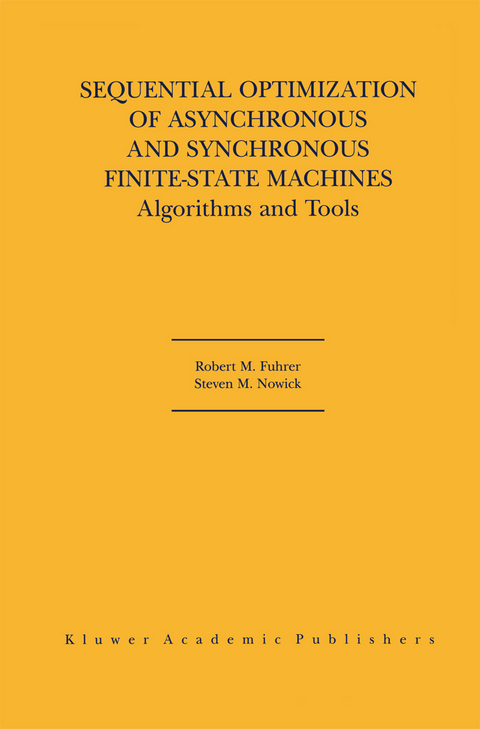
Sequential Optimization of Asynchronous and Synchronous Finite-State Machines
Springer-Verlag New York Inc.
978-1-4613-5543-4 (ISBN)
Sequential Optimization of Asynchronous and Synchronous Finite-State Machines: Algorithms and Tools makes three contributions to the field of sequential optimization for finite-state machines: 1) it introduces several new provably-optimal algorithms for the synthesis and optimization of asynchronous finite-state machines (FSMs); 2) it presents practical software implementations of each of these algorithms; and 3) it introduces a complete new CAD package, called MINIMALIST, binding these tools into a state-of-the-art technology-independent synthesis path for `burst-mode' asynchronous circuits. Throughout this book, real-world industrial designs are used as benchmark circuits to validate the usefulness of the tools. As an additional benefit, some of the theory and tools also provide new methods for the optimization of synchronous FSMs.
1. Introduction.- 1.1 The Case for Asynchronous Circuits.- 1.2 Asynchronous Controllers.- 1.3 Sequential Synthesis.- 1.4 Toward Global Solutions to Optimal Synthesis.- 1.5 Asynchronous Sequential Synthesis.- 1.6 Book Contributions.- 1.7 Outline of Book.- 2. Background.- 2.1 Finite State Machines.- 2.2 Boolean Functions and Logic Synthesis.- 2.3 Sequential Hazards.- 2.4 Input Encoding.- 2.5 Unate and Binate Covering.- 3. Burst-Mode Synthesis Path Walk-Through.- 4. CHASM: Optimal State Assignment for Asynchronous FSM’s.- 4.1 Overview of CHASM.- 4.2 Background: Optimal State Assignment for Synchronous Machines.- 4.3 Problem Statement and CHASM Overview.- 4.4 Multiple-Valued Hazard-free 2-Level Logic Minimization.- 4.5 CHASM Method.- 4.6 Optimal State Assignment with Fed-back Outputs.- 4.7 Theoretical Results.- 4.8 Experimental Results.- 5. OPTIMIST: Optimal State Minimization for Synchronous FSM'S.- 5.1 Introduction.- 5.2 Background and Related Work.- 5.3 Optimal State Minimization: Overview.- 5.4 Symbolic Primes: RGPI’s.- 5.5 Constraint Generation.- 5.6 Symbolic Instantiation.- 5.7 Examples.- 5.8 Theoretical Results.- 5.9 Efficient RGPI Generation.- 5.10 Experimental Results.- 5.11 Conclusions and Future Work.- 6. Optimisto: Synchronous State Minimization for Optimum Output Logic.- 6.1 Introduction.- 6.2 Output-Targeted Minimization for Synchronous FSM’s.- 6.3 Example.- 6.4 Theoretical Results.- 6.5 Cost Function.- 6.6 Experimental Results.- 6.7 Conclusions and Future Work.- 7. OPTIMISTA: Asynchronous State Minimization for Optimum Output Logic.- 7.1 The Challenge of State Mapping for OPTIMISTA.- 7.2 OPTIMISTA: Method Flow.- 7.3 State Compatible Generation.- 7.4 Symbolic Prime Implicant Generation.- 7.5 Binate Constraint Generation.- 7.6 State MappingIncompatibility Constraints.- 7.7 Binate Constraint Solution.- 7.8 Instantiation.- 7.9 Theoretical Results.- 7.10 Efficient Generation of State Mapping Incompatibility Constraints.- 7.11 Experimental Results.- 7.12 Conclusions and Future Work.- 8. MINIMALIST: An Extensible Toolkit for Burst-Mode Synthesis.- 8.1 Introduction.- 8.2 Background and Overview.- 8.3 MINIMALIST Framework.- 8.4 MINIMALIST Tools.- 8.5 A Synthesis Session.- 8.6 Experimental Results.- 8.7 Conclusion.- 9. Conclusions.- Appendices.- Multiple-Valued Hazard-free Logic Minimization.- A.1 Multiple-Valued Functions and Hazards.- A.2 Circuit Model.- A.3 Multiple-Valued Multiple-Input Changes.- A.4 Multiple-Valued Function Hazards.- A.5 Multiple-Valued Logic Hazards.- A.6 Problem Abstraction.- A.7 Symbolic Hazard-Free Minimization.- A.7.1 Conditions for a Hazard-Free Transition.- A.7.2 Hazard-Free Covers.- A.7.3 Exact Hazard-Free Multiple-Valued Minimization.- A.7.4 Generation of MVI DHF-Prime Implicants.- A.7.5 Generation of the DHF-Prime Implicant Table.- A.7.6 Generation of a Minimum Cover.- A.7.7 Multiple-Output Minimization.- Efficient Generation of State Mapping Constraints.- B.1 Horizontal Required Cubes.- B.2 Vertical Required Cubes.- MINIMALIST Shell and Command Set.
| Zusatzinfo | XXIII, 258 p. |
|---|---|
| Verlagsort | New York, NY |
| Sprache | englisch |
| Maße | 155 x 235 mm |
| Themenwelt | Informatik ► Weitere Themen ► CAD-Programme |
| Technik ► Elektrotechnik / Energietechnik | |
| ISBN-10 | 1-4613-5543-5 / 1461355435 |
| ISBN-13 | 978-1-4613-5543-4 / 9781461355434 |
| Zustand | Neuware |
| Haben Sie eine Frage zum Produkt? |
aus dem Bereich


